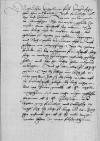Wÿ wir von den gnaden des almechtigen mÿt den unsern gesundt in unsere Ermland (Warmia, Varmia), diocese and ecclesiastical principality in northeastern Poland, 1466-1772 within the Kingdom of Poland, Royal Prussia⌊newe herschafftErmland (Warmia, Varmia), diocese and ecclesiastical principality in northeastern Poland, 1466-1772 within the Kingdom of Poland, Royal Prussia⌋ sein ankomen, / seÿ wir durch vyl der unsern bericht / des(s) thodtslages, so Mattis von Elditten ⌊Mattes von EldittenMattis von Elditten ⌋ begangen / und noch vÿler demuetiger bytt, an unss geschenn, / mit antzeÿgung, / wÿ das theters freunde / beÿ des erslagenen freuntschafft / solche sache in vortrag zu bringen vÿlmals gesucht haben / und bys her nichts haben mugenn(n) erlangen, / und yst alein alles zu E(wer) F(urstlichen) D(urchlauch)t gestaldt, / wÿ dÿ selbtige nun auch ÿst ersucht worden. / Hatt sy dÿ sache weÿtter uff dÿ freuntschafft gelegt, / dÿ doch nichts anders, wÿ zuvor gemeldt, E(wer) D(urchlauch)t wyllen nachgehenn, / hab wir nicht mugen nachlassen, hirynnen E(wer) F(urstliche) D(urchlauch)t zubesuchen. / Und bÿtten gantz freuntlich und vleÿssig, / dÿ weÿl sich dÿ sache so lange, nun bis in zweÿ jhar, erstreckt hat, / E(wer) F(urstliche) D(urchlauch)t wolle dem genanten Mattis von Elditten ⌊theterMattis von Elditten ⌋ in yrem Prussia, region in central Europe, bordered by Pomerania, Poland, Lithuania and Livonia. From 1466 Prussia was divided into Royal Prussia (Prussia Regalis), which was a part of the Kingdom of Poland, and Teutonic Prussia (Prussia Ordinis Theutonici) – covering the remnants of the former territory of the Teutonic Order’s state in Prussia. In 1525, the Order’s last Grand Master, Albrecht von Hohenzollern, converted to Lutheranism and became the first lay duke in former Teutonic Prussia (dux in Prussia), which from then on was called Ducal Prussia (Prussia Ducalis). At that time, as a result of the treaty of Cracow, Ducal Prussia became a fief of the kings of Poland⌊furstenthumbePrussia, region in central Europe, bordered by Pomerania, Poland, Lithuania and Livonia. From 1466 Prussia was divided into Royal Prussia (Prussia Regalis), which was a part of the Kingdom of Poland, and Teutonic Prussia (Prussia Ordinis Theutonici) – covering the remnants of the former territory of the Teutonic Order’s state in Prussia. In 1525, the Order’s last Grand Master, Albrecht von Hohenzollern, converted to Lutheranism and became the first lay duke in former Teutonic Prussia (dux in Prussia), which from then on was called Ducal Prussia (Prussia Ducalis). At that time, as a result of the treaty of Cracow, Ducal Prussia became a fief of the kings of Poland⌋ /  GStA PK, HBA, C1, No 489 2 unnumbered ein christlich, freÿ, sicher geleydt ab und zu von unsern wegen leÿsten und gebenn(n), / uns hirynne wÿlforen / und den ungenedigen wyllen in gnaden wenden. / Das sein wir umb E(wer) F(urstliche) D(urchlauch)t, in der gunst wir uns stain⌈[s]s stain⌉ thun befelhen, freuntlicher weis zuvordynen geneÿgt. /
GStA PK, HBA, C1, No 489 2 unnumbered ein christlich, freÿ, sicher geleydt ab und zu von unsern wegen leÿsten und gebenn(n), / uns hirynne wÿlforen / und den ungenedigen wyllen in gnaden wenden. / Das sein wir umb E(wer) F(urstliche) D(urchlauch)t, in der gunst wir uns stain⌈[s]s stain⌉ thun befelhen, freuntlicher weis zuvordynen geneÿgt. /
 GStA PK, HBA, C1, No 489 3 unnumbered
GStA PK, HBA, C1, No 489 3 unnumbered  GStA PK, HBA, C1, No 489 1 unnumbered
GStA PK, HBA, C1, No 489 1 unnumbered  GStA PK, HBA, C1, No 489 2 unnumbered ein christlich, freÿ, sicher geleydt ab und zu von unsern wegen leÿsten und gebenn(n), / uns hirynne wÿlforen / und den ungenedigen wyllen in gnaden wenden. / Das sein wir umb E(wer) F(urstliche) D(urchlauch)t, in der gunst wir uns stain⌈[s]s stain⌉ thun befelhen, freuntlicher weis zuvordynen geneÿgt. /
GStA PK, HBA, C1, No 489 2 unnumbered ein christlich, freÿ, sicher geleydt ab und zu von unsern wegen leÿsten und gebenn(n), / uns hirynne wÿlforen / und den ungenedigen wyllen in gnaden wenden. / Das sein wir umb E(wer) F(urstliche) D(urchlauch)t, in der gunst wir uns stain⌈[s]s stain⌉ thun befelhen, freuntlicher weis zuvordynen geneÿgt. /


